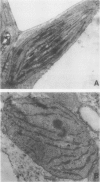Abstract
We report the recovery of a nuclear recessive mutation in Nicotiana sylvestris (Spegazzini and Comes) producing a conditional disruption in the pathway for synthesis of chlorophyll a and b and carotenoids which is fully reversible by exogenous thiamine (0.3 micromolar). In the absence of supplemental thiamine, chlorophyll levels declined by 50% after 5 days, and fell to undetectable levels by 11 days. Mitochondrial (KCN sensitive) respiration rates remained normal in albino leaves (80% loss of chlorophyll), suggesting that chlorosis results primarily from a deficiency of thiamine in the chloroplasts. After thiamine removal, mutant plants produced at least 10 albino leaves with a substantial capacity for growth (0-15 centimeters; 70-fold increase in area), demonstrating sustained operation of many cellular functions in spite of chloroplast disruption. Activities of the plastid isozymes of phosphoglucomutase and phosphoglucoisomerase in albino leaves indicated that the decline in pigment synthesis does not result from a general loss of metabolic activity in chloroplast. Plastid pyruvate dehydrogenase from mutant and wild-type plants displayed a similar affinity for thiamine pyrophosphate, showing that chlorosis does not result from an alteration in this enzyme. Growth of albino leaves and ultrastructural evidence for thylakoid membranes in the chloroplasts suggest that a certain level of fatty acid synthesis is maintained after the interruption of pigment synthesis. Since thiamine deprivation is expected to block production of acetyl-coenzyme A from pyruvate by pyruvate dehydrogenase, acetyl-coenzyme A supporting fatty acid synthesis in albino leaves may be derived solely from mitochondrial acetate.
Full text
PDF





Images in this article
Selected References
These references are in PubMed. This may not be the complete list of references from this article.
- Arnon D. I. COPPER ENZYMES IN ISOLATED CHLOROPLASTS. POLYPHENOLOXIDASE IN BETA VULGARIS. Plant Physiol. 1949 Jan;24(1):1–15. doi: 10.1104/pp.24.1.1. [DOI] [PMC free article] [PubMed] [Google Scholar]
- Camp P. J., Randall D. D. Purification and Characterization of the Pea Chloroplast Pyruvate Dehydrogenase Complex : A Source of Acetyl-CoA and NADH for Fatty Acid Biosynthesis. Plant Physiol. 1985 Mar;77(3):571–577. doi: 10.1104/pp.77.3.571. [DOI] [PMC free article] [PubMed] [Google Scholar]
- Kuhn D. N., Knauf M., Stumpf P. K. Subcellular localization of acetyl-CoA synthetase in leaf protoplasts of Spinacia oleracea. Arch Biochem Biophys. 1981 Jul;209(2):441–450. doi: 10.1016/0003-9861(81)90301-5. [DOI] [PubMed] [Google Scholar]
- Li S. L., Rédei G. P. Thiamine mutants of the crucifer, Arabidopsis. Biochem Genet. 1969 Apr;3(2):163–170. doi: 10.1007/BF00520351. [DOI] [PubMed] [Google Scholar]
- Weeden N. F., Gottlieb L. D. Dissociation, reassociation, and purification of plastid and cytosolic phosphoglucose isomerase isozymes. Plant Physiol. 1982 Mar;69(3):717–723. doi: 10.1104/pp.69.3.717. [DOI] [PMC free article] [PubMed] [Google Scholar]
- Williams M., Randall D. D. Pyruvate Dehydrogenase Complex from Chloroplasts of Pisum sativum L. Plant Physiol. 1979 Dec;64(6):1099–1103. doi: 10.1104/pp.64.6.1099. [DOI] [PMC free article] [PubMed] [Google Scholar]



